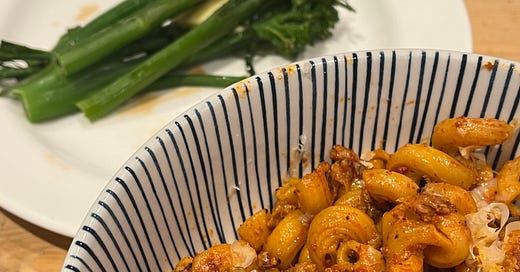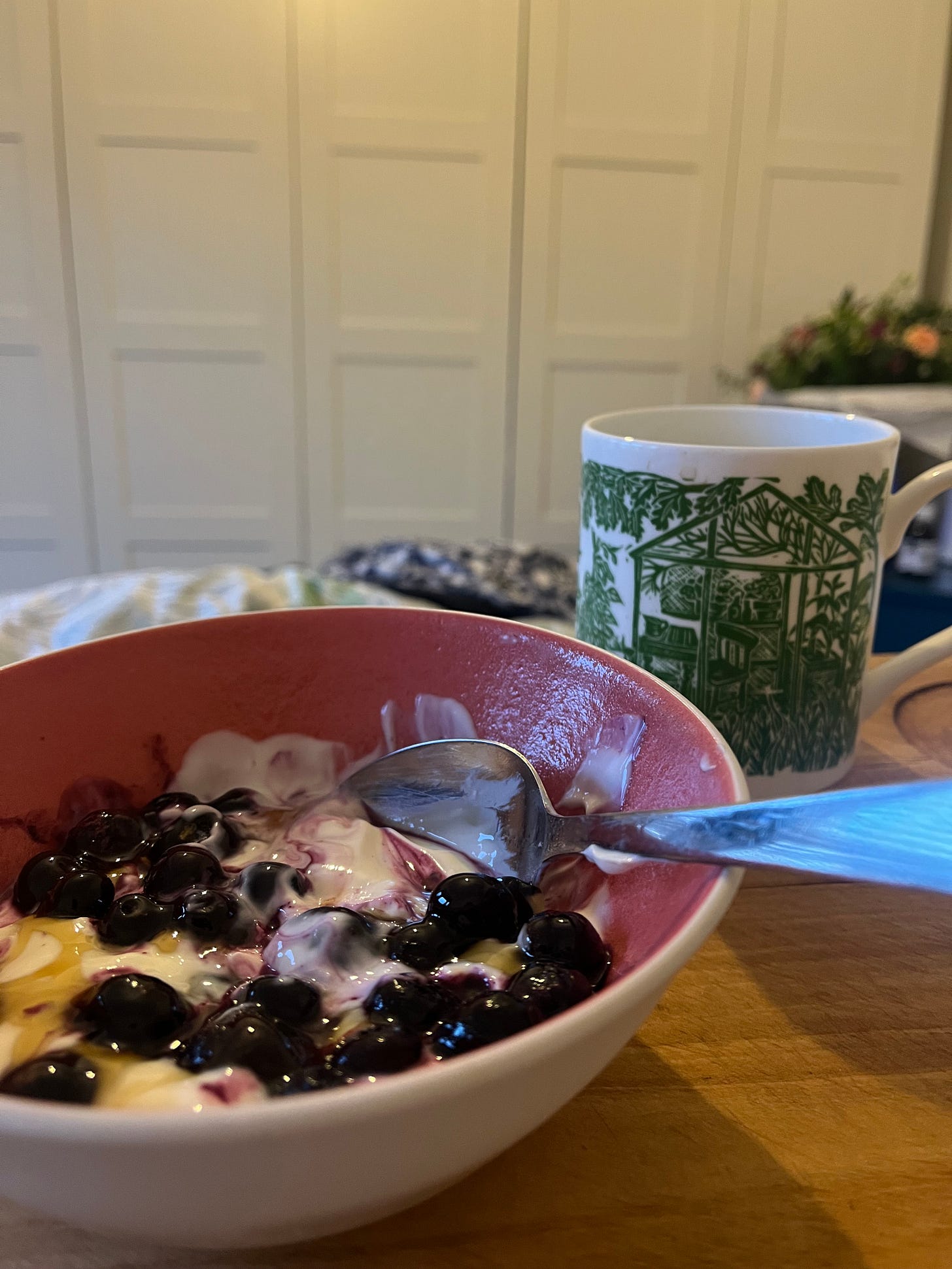Hello Everyone!
This is not the post I was planning. I had thought I would start sending out some of the posts I had banked ahead of last week’s surgery, but I find that I have a window in the brain fog and I want to write, so I shall save them for when I need them. These Last Night’s Dinner posts usually have the method paywalled, but it is such a simple one it doesn’t seem worth it, so as a one off, the whole of the post is open access.
Also - I know I am posting something very simple here, but there is, I think, useful information on adapting recipes. So still relevant!
Today’s recipe is based on one from Everyday Pressure Cooking and cooked by my wonderful 14 year old son who is taking over most of the cooking for a while. I have been home since Saturday and so far he has made me:
Scrambled eggs, with some smoked salmon and hot buttered toast and remembered a squeeze of lemon on the smoked salmon too.
A breakfast of yogurt, blueberries and raw honey
A snack of hummus with carrot sticks, and he added olive oil, turmeric, BP and cinnamon to the hummus
Pasta - the subject of today’s post, with buttered sprouting broccoli
And breakfast this morning - bacon and eggs with toast and some kimchi on the side (working hard at countering all the antibiotics).
His father has heated up soup from the freezer. But also panicked the other day and bought a thermos filled with a Covent Garden soup to hospital instead. Which was still a million miles better than the hospital food. And nice pastries and a prawn cocktail when I craved it.
Now, please allow me a little rant before I get onto the recipe.
The hospital food.
I honestly cannot believe quite how appalling. Some of you might have seen my notes about it. One of the reasons Adam was keen to give me toast on my first evening back was because he wanted to banish the memory of the hospital toast in all its cold and rubbery glory. The first night post op started well, because there was a mild vegetable curry on offer which was actually really nice. But it was the only decent meal in almost 4 days. Most of it was really bland, gloopy and highly processed tasting versions of cottage pies/thickened casseroles etc. This surprised me because there is a large South Asian/African/Caribbean demographic in my area and I didn’t feel they were catered for much at all.
The vegetables were GRIM. Most people left them. Grey peas with a mac n cheese - cooked to death but watery, not sweet. Carrots which managed to be underdone and also watery, not sweet. I thought perhaps it is because I am used to the depth of flavour brought out by pressure cooking - but then that would mean all the non pressure cooker meals I’ve eaten would also suffer by comparison and many of them don’t - not by much, anyway.
Desserts - highly processed yogurts or jelly. Fresh fruit - mushy, mealy apples, bananas.
I can’t bring myself to include any of the photos I took. Just too depressing.
Anyway, I know there are massive budget constraints in the NHS but really, they must be able to do better. Nutrition is such an important part of recovery. And ironically, the hospital takes part in an Enhanced Recovery Programme which puts an emphasis on just that - looking at diet/exercise/lifestyle before and after relevant surgeries. I felt increasingly sorry for the one person (in a room of six), who was dependent solely on the hospital food as her meals were often cold and congealed - they were bad enough piping hot. Especially as the room was frequently filled with enticing smells of food brought from home - thermoses very much in use! Actually that aspect was very encouraging. Home cooked meals from scratch very much in abundance via relatives. But those poor patients with no one to visit them or able to cook for them.
Anyway, back to home cooking, thank goodness.
Yesterday was the first time my son had used the pressure cooker on his own, without my supervision. His dad was in the kitchen with him, but he has never used one either. This is my fault, always having to be in control in the kitchen. I’m hoping the next few weeks are going to do me no end of good in that regard. So Adam went through the recipe with me, worked out how he needed to amend it and got to it. And did a really good job. There were little things - I needed to explain the importance of deglazing. He used a bit too much tomato puree and not quite enough water so the top layer was a bit firm - but I just told him to stir, add a bit more water and cook again at pressure for another minute and this time it was fine. He was perfectionist about it and said it was a bit dry. I told him it was cooked perfectly, tasted wonderful (it did!) and when he asked (only then because I didn’t want to offer criticism, only advice), told him that a splash of water stirred into the pasta on a low heat would have stopped the sauce being dry. It was really interesting and useful for me to have someone cook my recipe in real time. I deliberately stayed upstairs which was I think the right thing to do.
He managed to cook the sprouting broccoli too, and added plenty of butter. Always a good thing.
Yesterday’s Pasta, Based on Favourite Packed Lunch Pasta from Everyday Pressure Cooking.
(Makes 2 portions, rather than the usual 4)
2 tbsp olive oil
2 sausages, skinned and formed into small balls
½ onion, finely diced (or 2 cubes of sofrito if you have any)
½ tsp dried oregano
1/2 tsp dried thyme
1/4 tsp ground cinnamon
2 garlic cloves, finely chopped
2 tbsp tomato puree
20g red lentils, unrinsed
250g short pasta
To serve:
Grated parmesan or any other type of cheese, in a separate pot.
Heat your pressure cooker and add the oil. Add the sausage balls and fry quickly on 2 sides until lightly browned. Push to one side and add the onion. Saute for another couple of minutes. Add the herbs, cinnamon, and garlic to the pressure cooker and saute for another minute. Mix the tomato puree with some water to loosen and stir in.
Sprinkle in the red lentils and pasta. Add enough water to just cover the pasta and stir thoroughly to make sure the base of the cooker is deglazed. Season with salt and pepper. Close the lid, bring up to high pressure and adjust the heat to maintain the pressure. Cook for 5 minutes, then carefully fast release the pressure.
Leave to stand for a couple of minutes before serving.
A couple of points on the tricky tomato puree.
I know some of you using electric pressure cookers will say that stirring in the tomato puree before adding the pasta and bulk of the water might mean you get a burn notice. If you are worried about this, you can just squeeze some over once everything else is in the pot and stir it in at the end - it will still taste cooked out. In my original recipe, the tomato puree is stirred in without being diluted. This is because the original recipe had courgettes in it; courgettes start giving out quite a lot of liquid as soon as you start cooking them - they also cook very quickly. Stirring tomato puree around them helps to slow down the rate at which they cook. And because they have started giving out liquid, it’s not going to catch.
Thank you for reading! Please share this post with anyone you think might like it and also, please do click on the heart - that’s all it takes to get the post out there a bit more!






Adam sounds completely wonderful ❤️
The story of your son is inspiring! Greet life skills.